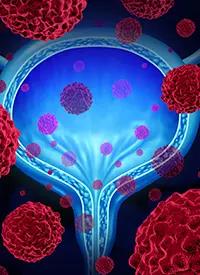News
Article
Avelumab Plus Cisplatin-Based Chemotherapy Yields High EFS and OS Rates in MIUC
Author(s):
Key Takeaways
- High EFS and OS rates were achieved in cisplatin-eligible patients, especially with the ddMVAC regimen.
- Cisplatin-ineligible patients showed lower survival outcomes with no additional benefit from paclitaxel/gemcitabine.
The addition of avelumab to cisplatin-based chemotherapy led to high event-free survival and overall survival rates in patients with muscle-invasive urothelial carcinoma.
Neoadjuvant avelumab plus
cisplatin-based chemotherapy in MIUC

Event-free survival (EFS) and overall survival (OS) rates were high at 12- and 36-months among patients with muscle-invasive urothelial carcinoma treated with neoadjuvant avelumab (Bavencio) plus cisplatin-based chemotherapy, according to data from the phase 2 AURA trial (NCT03674424) presented at the 2024 ASCO Annual Meeting.
“In the cisplatin-eligible cohorts, we showed that high EFS and OS rates can be achieved at 12 and 36 months in patients treated with neoadjuvant avelumab in combination with cisplatin-based chemotherapy, and in particular, in patients treated with the dose-dense MVAC [ddMVAC] regimen. In the cisplatin-ineligible cohort, as expected, we show a lower survival outcome at 12 months with no additional benefit of [the] paclitaxel/gemcitabine regimen,” lead author Jeremy Blanc, MD, of the Institut Jules Bordet, Hôpital Universitaire de Bruxelles, and Université Libre de Bruxelles, said during the presentation.
In the cisplatin-eligible cohort, the 12- and 36-month EFS rate among those receiving the ddMVAC regimen was 92% and 79%, respectively. The 12- and 36-month EFS rate among those receiving gemcitabine/cisplatin plus avelumab was 84% and 62%, respectively. Regarding OS, those receiving the ddMVAC regimen achieved an OS rate of 95% at 12 months and 85% at 36 months. Those receiving gemcitabine/cisplatin plus avelumab achieved an OS rate of 92% at 12 months and 64% at 36 months.
In the cisplatin-ineligible cohort, the 12-month EFS rate was 64% among patients who received avelumab alone and 60% among those who received paclitaxel/gemcitabine plus avelumab. The 12-month OS rate was 79% among those who received avelumab alone and 82% among those who received paclitaxel/gemcitabine plus avelumab. At the time of data report, 36-month data for these patients were not yet mature.
Data from both the cisplatin-eligible cohorts and the cisplatin-ineligible cohorts also showed that achieving a pathological complete response was associated with improved OS.
“As we know, cisplatin-based neoadjuvant chemotherapy followed by surgery is the standard treatment in non-metastatic muscle invasive bladder cancer. Unfortunately, nearly half of the patients are not fit enough to receive cisplatin-based chemotherapy,” Blanc said.
In AURA patients were stratified by cisplatin eligibility. Patients who were eligible for cisplatin were randomly assigned 1:1 to either gemcitabine/cisplatin plus avelumab or to ddMVAC plus avelumab. Patients who were not eligible to receive cisplatin were randomly assigned 1:1 to receive paclitaxel/gemcitabine plus avelumab or to avelumab alone.
Previously reported data from the study showed a pathological complete response rate of 58% with ddMVAC, 52% with gemcitabine/cisplatin plus avelumab, 32% with avelumab alone, and 14% with paclitaxel/gemcitabine plus avelumab. The current analysis focused on the key secondary end points of EFS and OS.
The phase 2 AURA trial is a multi-centric, randomized, non-comparative study to explore neoadjuvant avelumab alone or in combination with chemotherapy. To be included in the trial, patients needed to have pathologically-confirmed MIUC with planned radical cystectomy and lymphadenectomy.
The primary end point for the trial was the proportion of patients who achieved a pathological complete response. Secondary end points included the proportion of patients who achieved a <ypT2N0, safety, and EFS and OS at the 12- and 36-month time points.
“We know that further investigation through a phase 3 trial is very important to validate our findings. We believe that the identification of biomarkers could also optimize muscle-invasive bladder cancer care and patient selection,” Blanc concluded in the presentation.
Reference
Blanc J, Carnot A, Barthelemy P, et al. Avelumab (A) as neoadjuvant therapy in patients (pts) with muscle-invasive urothelial carcinoma (MIUC): Survival data of AURA trial, Oncodistinct 004. Presented at: 2024 American Society for Clinical Oncology Annual Meeting. May 31-June 4, Chicago, Illinois. Abstract 4516. https://ascopubs.org/doi/10.1200/JCO.2024.42.16_suppl.4516








